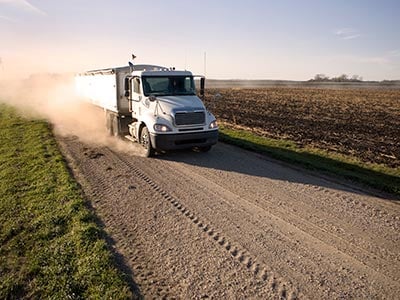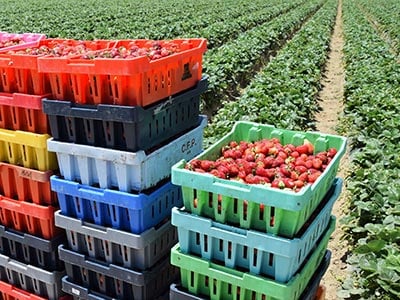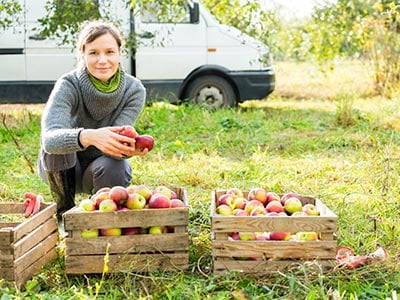Agriculture Transportation
Whether you are transporting your house plants or produce you grew, moving agriculutral goods can be tough. You want to make sure the plants arrive the same way they left. Finding a carrier who specializes in transporting agricultural goods and plants can be difficult, especially at an affordable rate. If you are moving to a new home and want your plants to come with you or if you are a business owner trying to move your product, you can’t afford to lose more money.
Find a carrier with experience moving plants and produce. Try to locate more than one so you can research and compare. Discover which carrier has the best rates with the best service to safely meet your agricultural transport needs. Talk to them and find out more about their experience and know-how when it comes to moving plants. You can do this on your own or you can use uShip as your one stop shop for finding, researching, and comparing plant transportation companies.

When to Take Your Plants with You
Consider your options when it comes to moving your household or garden plants. Many movers can accommodate small plants, but larger plants may need a specialized carrier, a driver who knows how to care for plants while in transit.
When to Move Your Plants:
- They have sentimental value and you do not want to part with them
- You’ve spent a lot of time cultivating them or they are a rare species (e.g. Bonsais)
- They are small enough to be easily packaged for quick shipping
- They would be difficult to buy at your new location
- They are large and would be costly to crate and move
When to Take Your Plants with You
Consider your options when it comes to moving your household or garden plants. Many movers can accommodate small plants, but larger plants may need a specialized carrier, a driver who knows how to care for plants while in transit.
When to Move Your Plants:
- They have sentimental value and you do not want to part with them
- You’ve spent a lot of time cultivating them or they are a rare species (e.g. Bonsais)
- They are small enough to be easily packaged for quick shipping
- They would be difficult to buy at your new location
- They are large and would be costly to crate and move

Preparing Your Plants for Shipment
Shipping Small and Medium Sized Plants:
- 1. Keep your plants moist during transport by thoroughly watering in advance, wrapping newspaper around the pot, and placing burlap around the leaves and stems.
- 2. Transfer plants from breakable pots into sturdy plastic containers.
- 3. Place pots in a carton for easier transport.
Shipping Large Plants, Trees, or Shrubs:
- 1. Moving large plants should be done when the plant is dormant.
- 2. Root the plant a year before you plan to move it. Using a sharp spade, dig a trench around the plant that is about two feet deep and as wide as the spade. In the procs, you will sever the roots. The trench should be three to four feet from a small tree or shrub, five to eight feet from a larger one.
- 3. Fill the trench with sphagnum moss. The plant will form a compact root system inside the boundary and will be better able to withstand the move.
- 4. Prune the plant well several weeks before transplanting.
- 5. Wait until you are ready to move the plant, and then dig a trench in a circle at least a foot from the crown. Dig down at least two feet, separating a ball of earth that includes the roots.
- 6. Rock the ball gently back and forth until it moves loosely, and you can lift it out of the hole. Use a board for leverage, and get help for this part of the process – even small shrubs are heavy.
- 7. Set the plant and its ball of soil on a piece of burlap, wrap the burlap around the soil to keep it from crumbling, and move it to a spot protected from sun and strong winds. Remember to slide the plant, never roll it, and take care not to let it drop – roots are fragile.
- 8. Wait at least two weeks before replanting. Meanwhile, keep the plant in its sheltered spot and water often and gently, keeping the soil moist.
Preparing Your Plants for Shipment
Shipping Small and Medium Sized Plants:
- 1. Keep your plants moist during transport by thoroughly watering in advance, wrapping newspaper around the pot, and placing burlap around the leaves and stems.
- 2. Transfer plants from breakable pots into sturdy plastic containers.
- 3. Place pots in a carton for easier transport.
Shipping Large Plants, Trees, or Shrubs:
- 1. Moving large plants should be done when the plant is dormant.
- 2. Root the plant a year before you plan to move it. Using a sharp spade, dig a trench around the plant that is about two feet deep and as wide as the spade. In the procs, you will sever the roots. The trench should be three to four feet from a small tree or shrub, five to eight feet from a larger one.
- 3. Fill the trench with sphagnum moss. The plant will form a compact root system inside the boundary and will be better able to withstand the move.
- 4. Prune the plant well several weeks before transplanting.
- 5. Wait until you are ready to move the plant, and then dig a trench in a circle at least a foot from the crown. Dig down at least two feet, separating a ball of earth that includes the roots.
- 6. Rock the ball gently back and forth until it moves loosely, and you can lift it out of the hole. Use a board for leverage, and get help for this part of the process – even small shrubs are heavy.
- 7. Set the plant and its ball of soil on a piece of burlap, wrap the burlap around the soil to keep it from crumbling, and move it to a spot protected from sun and strong winds. Remember to slide the plant, never roll it, and take care not to let it drop – roots are fragile.
- 8. Wait at least two weeks before replanting. Meanwhile, keep the plant in its sheltered spot and water often and gently, keeping the soil moist.

Caring for a Plant in Transit
Plants are not dry freight, and are much more fragile and prone to damage. Hire a professional plant transporter with experience. Find a driver whom you feel comfortable communicating plant care instructions. Learn about the plant transportation process. Ask about the conditions your plant will be exposed to. Will it be transported in open air or an enclosed area? Will the plants be covered at night? Consider having larger plants professionally crated. This will help keep the plant safe and secure while in transit.
Caring for a Plant in Transit
Plants are not dry freight, and are much more fragile and prone to damage. Hire a professional plant transporter with experience. Find a driver whom you feel comfortable communicating plant care instructions. Learn about the plant transportation process. Ask about the conditions your plant will be exposed to. Will it be transported in open air or an enclosed area? Will the plants be covered at night? Consider having larger plants professionally crated. This will help keep the plant safe and secure while in transit.
How Much Does It Cost to Ship Plants?
The average cost for agriculture shipping depends on the distance. It costs $2.03 per mile to transport agriculture less than 100 miles, but costs $1.46 per mile to transport agriculture less than 1000 miles.
Visit our cost to ship agriculture pages for an inside look at the uShip agriculture transport process. There, you’ll be able to view produce and plant transport completed through the uShip marketplace. Being familiar with the process is key to getting a great shipping experience with uShip.
How to Transport Live Plants
First, be sure it is legal to send the plants to the destination you have in mind. When transporting plants across state or national borders, be aware of strict rules regarding the import and export of plants. In many cases, import or export laws and customs delays make it difficult to ship live plants across national borders. When shipping a load of live plants, be aware that your shipment is vulnerable to inspection by the U.S. Department of Agriculture, which could hold up the load by a day or more. If sending live plants via UPS or another standard carrier, it’s best to send them at the beginning of the week so that they won’t run the risk of sitting neglected over a weekend.
Climate
When transporting live plants, remember that climate at the origin, en route, and destination are very important. Plants that thrive in one part of the country may not be very hardy in other parts. Fortunately, it is easy to determine the climate needs of a particular plant. Check the weather at the destination and along the planned route. If your plants might be harmed by freezing temperatures, make sure they won’t pass through a cold zone.
Temperature
Before shipping your plant, find out more about the range of temperatures that it can endure online or by asking your local plant store. The U.S. Department of Agriculture also publishes a Plant Hardiness Zone Map which is used to determine the normal temperature range of different areas across the country, as well as how different plants react to certain climates. This will help you decide whether your plant will be able to survive in its destination.
Light
Check to see that your plant’s destination provides enough days of sun each year for your plant to survive. If your plant thrives without much direct sunlight, find a shady location for it to be moved to before your plant transporter arrives. If you are moving to a region where the days are usually overcast, however, plants that need lots of light may be hard to cultivate. Leave these plants behind or donate them to a local school or garden.
Water
The amount of rainfall that a region plant gets is closely tied to how many sunny days there are per year. Pay special attention to this factor especially if you are moving from an area characterized by dry weather to one where it rains much of the year. Just as a plant that requires dry, well-drained soil is unlikely to survive constant moisture, a plant that needs constant watering will have difficultly surviving in a very dry environment.
Climate for Transportation of Plants
Although you can control all four of the above variables at the plant’s origin and destination, this is much harder to do when a plant is in transport. Find out if your plant mover is knowledgeable in transporting live plants and is able to accommodate their specific needs. Ask if your plants will be transported in an enclosed trailer or exposed to the elements, and check weather forecasts in advance to make appropriate preparations for very hot or cold temperatures. It may also be helpful to provide your service provider with clear, written directions on the kind of care your plants need.
Shipping Plants with uShip
Shipping plants and agricultural goods is easy with uShip. Simply create a shipment listing detailing your needs for your plant transportation. Once you’ve entered in all your needs for your shipment, you will start getting transportation rates from carriers who specialize in plant shipping as they compete for your business – ensuring you get the lowest rates from the best transporters. As the shipping companies submit their quotes, talk to them directly to find out more about their communication and experience. You can also look at their uShip carrier profile to see ratings and reviews from their previous customers. When you have found a service provider you are comfortable with and a rate within your budget, accept their quote and you’re on your way to your plant delivery.
READY FOR YOUR AGRICULTURE SHIPPING QUOTES?
Get StartedNeed to ship your equipment?
Learn MoreStates